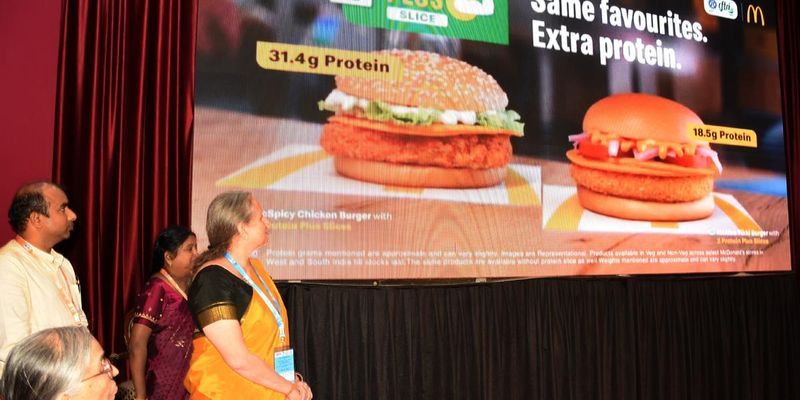Protein Halo: How McDonald's is Trickling Protein into Indian Consumers


The Protein Deficiency Crisis in India
India, a country that has long struggled with malnutrition and undernutrition, faces an alarming protein deficiency. According to the National Family Health Survey (NFHS), over 50% of children under five suffer from protein-energy malnutrition. Despite being one of the largest producers of milk, pulses, and legumes, the average Indian’s protein intake is significantly lower than the recommended daily intake. The average protein consumption in India is around 50-60 grams per day, but experts suggest that the ideal intake should be around 70 grams per day. This deficiency contributes to a variety of health problems, from stunted growth in children to weakened immune systems and an increased risk of chronic diseases.
The government and various health organizations have attempted to address this issue for years, but the message hasn’t always been well-received, and dietary habits remain largely unchanged. This is where McDonald’s Protein Plus Range comes into play: a savvy strategy to nudge Indian consumers toward healthier eating without completely overhauling their fast food habits.
The Rise of the Protein Trend: A New Food Revolution
Over the past few years, there has been a growing obsession with protein in India. From protein waters to protein-packed roti (flatbread), Indian food brands are pushing protein to the forefront of their offerings. This trend isn’t just limited to niche health food markets—it’s reaching mainstream audiences too. One standout example is Amul’s introduction of a high-protein kulfi, a frozen dessert that traditionally contained little to no protein. Similarly, brands like phab, a popular protein drink, and many others, have found ways to incorporate protein into everyday foods.
This surge in protein-focused products comes in response to changing consumer attitudes toward health and wellness. As urbanization increases and lifestyles become more sedentary, there is a growing recognition of the importance of nutrition in maintaining good health. Consumers, especially younger ones, are becoming more conscious of their protein intake, leading them to seek out innovative, protein-rich alternatives to traditional snacks and meals.
McDonald’s decision to join this protein revolution is both timely and strategic. With its deep penetration into the Indian market and a massive consumer base, McDonald’s is uniquely positioned to make protein more accessible to the masses. Their latest Protein Plus Range is a way to tap into the wellness zeitgeist while maintaining their commitment to delicious, convenient, and affordable food.
The Science Behind McDonald’s Protein Plus Slice
What makes McDonald’s Protein Plus Slice so special? Well, the key lies in its ingredients and the technology behind it. The slice is made from a blend of soy and pea proteins, two plant-based ingredients that are packed with essential amino acids—key building blocks for muscle growth and overall body function. This makes the protein slice not just an add-on to the meal, but a significant nutritional boost.
Each slice weighs around 15 grams and contains 5 grams of protein, making it a convenient and low-calorie way to up your protein intake without having to overhaul your meal. At just 34 calories per slice, it’s a relatively small addition to any burger or sandwich. More importantly, the slice is designed to be 100% vegetarian, free from artificial flavors, colors, and the common allergens onion and garlic, which makes it suitable for a wide variety of dietary preferences.
The product was developed in collaboration with CSIR-CFTRI, one of India’s most respected research institutions, under the Ministry of Science and Technology. The partnership with a government body lends an air of credibility to McDonald’s innovation, reassuring health-conscious consumers that the Protein Plus Slice is not just a marketing gimmick but the result of scientific research and collaboration. In fact, last year, McDonald’s India also introduced a multi-millet bun, another innovation developed in partnership with CSIR-CFTRI, showcasing the company’s long-term commitment to bringing healthy, nutritionally balanced options to its customers.
The Health Halo: Trick or Trend?
The concept of a “health halo” refers to the psychological phenomenon where consumers perceive a food product as healthier simply because it contains one or more nutritious components. McDonald’s Protein Plus Slice is a textbook example of this phenomenon. By adding a protein-packed slice to a burger, McDonald’s is giving customers the illusion of making a healthier choice—without altering the core components of the meal.
But is it really a health revolution, or just clever marketing? The answer lies in the context of the overall meal. While the slice adds 5 grams of protein, it doesn’t necessarily transform an otherwise unhealthy fast food meal into a nutritional powerhouse. If paired with a McSpicy Paneer burger, for example, the overall protein content of the meal increases to 25.29 grams, but the total calorie count and fat content remain relatively high. So, while it’s a great option for protein-hungry consumers looking to add a bit more muscle-building nutrition to their meal, it’s not a magic bullet for weight loss or overall health.
However, there’s no denying that the Protein Plus Slice is a step in the right direction. For many Indians, McDonald’s represents convenience, comfort, and affordability. By offering a protein-packed option, McDonald’s is meeting the evolving demands of health-conscious consumers who want to enjoy fast food without completely abandoning their wellness goals.
Is This a Nutritional Revolution or Just Hype?
McDonald’s India’s Protein Plus Slice, while innovative, is just one small piece of the larger nutritional puzzle. India’s protein deficiency is a complex issue that can’t be solved overnight. However, initiatives like this one could play a role in helping to raise awareness about the importance of protein in the diet. The real challenge lies in making protein-rich foods more accessible and affordable to the average Indian consumer, especially in rural areas where nutritional education and access to diverse foods are often limited.
McDonald’s, through this partnership with CSIR-CFTRI, is not just jumping on a bandwagon—it’s investing in long-term solutions that align with India’s health needs. If more brands follow suit, incorporating healthy ingredients into their existing products, India could see a significant improvement in its protein intake levels.
A Step in the Right Direction for India’s Health
McDonald’s Protein Plus Slice isn’t just a gimmick—it’s a clever fusion of innovation, nutrition, and convenience. While it may not be the ultimate solution to India’s protein deficiency, it represents an important shift in the right direction. For a country where 50% of children are affected by protein-energy malnutrition, even small steps like this could make a big difference.
The product caters not only to health-conscious consumers but also addresses the growing demand for vegetarian, plant-based protein options in India. As more and more people prioritize their health, fast food brands like McDonald’s have an opportunity to become agents of change in the fight against malnutrition.
So, next time you’re in the mood for a McDonald’s burger, consider adding the Protein Plus Slice. After all, it might not save the world, but it could be a small step toward saving India from a protein crisis.
Discover more from News Hub
Subscribe to get the latest posts sent to your email.







